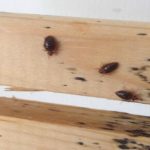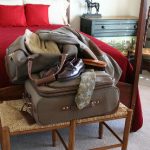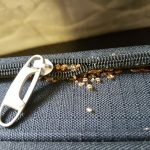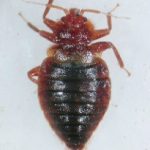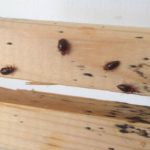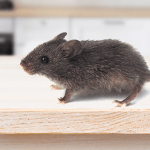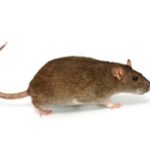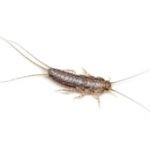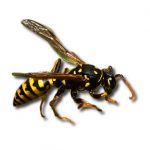Bed Bugs
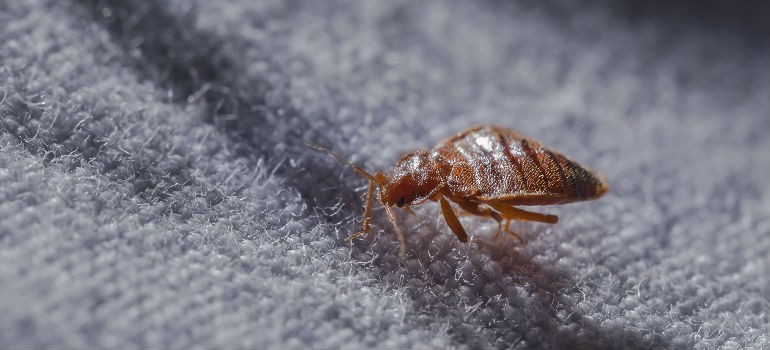
This pest profile is dedicated to a small (but very viscous) insect known as bed bug (Cimex lectularius). Here you can learn more about the appearance, feeding habits, detection, etc. of those blood-sucking creatures.
Continue reading below and you will also find answers to questions such as how can bed bugs be transported on clothing and how to get rid of them if a property gets infested. Without further ado let’s take a closer look at these pesky home invaders.
What Are Bed Bugs?
Bed bugs (Cimex lectularius) are tiny, wingless insects that feed on the blood of humans and animals, primarily when they sleep. They’re nocturnal little pests that like to remain hidden throughout the day, making them difficult to identify.
Adult bed bugs are brown or reddish-brown, oval-shaped, and have little front wings (but don’t worry, they don’t fly!). Their bodies are coated with microscopic hairs, and they grow to be approximately 4-5mm long and 1.5-3mm wide. Baby bed bugs, known as nymphs, start out practically clear and darken as they mature. There are many other pests that appear like bed bugs, like fleas, bird mites and dust mites, so it’s important to understand what you’re dealing with.
These pests like to hide in cracks, crevices, mattresses, and furniture, waiting for the right moment to emerge and feed. Bed bugs are skilled hitchhikers, entering homes through luggage, clothing, and secondhand furniture. This is why infestations are common in hotels, houses, and public areas. The trick is to spot them early and take action before they become a full-fledged infestation.
Check also:
Feeding Habits and What Exactly Attracts Bed Bugs?
Bed bugs have an appetite for blood and they would gladly feed on humans. Water vapor in the air is enough for their need for additional moisture. Just like the mosquito, bed bugs are attracted to hosts mainly by carbon dioxide. It loves exposed skin, especially the arms, neck, and face of a sleeping person. Under warm conditions, the adult bed bug will try to feed every 5 to 10 days but it can survive for nearly 5 months without blood. Under cool conditions, it can last for over a year without feeding.
Bed Bug Bites
If a person gets bitten, the most important thing is to be kept from being bitten repeatedly. Once all the biting stops, the symptoms will subside on their own without any treatment in about a week or two. There is no medical evidence that medications improve the condition of the victim. To avoid ongoing bed bugs bites can be difficult as it requires the complete eradication of all bed bugs that reside at a dwelling.
A bed bug infestation can lead to several health effects such as allergic symptoms, skin rashes, and even psychological problems. Depending on their number, bed bug bites can lead to a variety of skin problems such as gruesome blisters. About 30% of hosts respond to bites with reddish spots and itching that can last for a few days.
Some symptoms might be delayed and can appear several days after the actual bites took place. From a psychological point of view, an infestation can cause stress, sleep deprivation and anxiety.
Signs of Bed Bugs
Bed bugs are active during the night and act elusive. The peak of their activity is usually between 10 pm and 6 am. This makes their detection somewhat difficult. They prefer to hide in the darkest places you wouldn’t usually check.
Bite marks are the obvious symptoms but other bed bug signs include faecal matter in the form of small black droppings that might resemble black pepper. If you find some, then probably the nest is somewhere nearby.
This parasite doesn’t like to spend too much time on its host. Once done with feeding, it will return to a safe place where it won’t be noticed, typically a couch or somewhere near the bedding. These places are usually clustered with adults, young ones, and bed bug eggs.
Can Bed Bugs Be Transported on Clothing?
In short – yes, bed bugs can be carried on clothing. If you are working in an office or simply have constant contact with people, there is a chance for bed bugs to transfer to you. But don’t worry, there are ways to prevent it.
You can’t stop the bugs to go to your clothes, but you can stop them from spreading around your home. Here is how:
- If you have a suspicion that you are carrying the pests, go to a room without carpets or other clothing materials (e.g. bathroom).
- Remove your clothes and put them in plastic bags.
- They should remain there until the wear is ready to be laundered (with washing machine – at least 2 hours long wash cycle at 45°C) or frozen (at least a week, but it must be with really low temperatures -20°C/-30°C).
What Is the Main Cause of Bed Bugs Infestation?
Bed bugs mostly spread because of their cunning ability to leap on humans, luggage, clothing, and furniture. They simply go from place to place without anyone noticing to feed, they do not show up because of filth or poor hygiene. Among their favourite places to move are hotels, buses, dorms, and used furniture.
Masters of hide-and-seek, these small insects squeeze into tiny gaps and crevices where they can remain invisible until their population starts to rise. Once they come inside, they rapidly disperse on couches, mattresses, and other furniture, therefore making disposal of them a real difficulty.
Check also:
What is the First Thing To Do When You Have Bed Bugs?
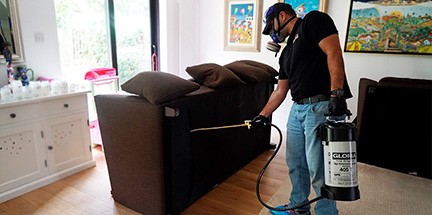 If you suspect or know for sure that your dwelling is infested with bed bugs, then you better enlist the help of bed bug exterminator right away. Do not attempt to deal with the situation on your own as you might not be using the right pesticides.
If you suspect or know for sure that your dwelling is infested with bed bugs, then you better enlist the help of bed bug exterminator right away. Do not attempt to deal with the situation on your own as you might not be using the right pesticides.
Bed bugs are very intuitive and they will be on the move once they sense you are on to them. That is why you need the help of specialists who know what chemicals will work best against the pesky insects. This is the only way to be sure that the colony will be isolated and effectively eradicated.
Treatments That Kill Bed Bugs Permanently
Heat treatment
High temperatures are too much for bed bugs to withstand; anything over 49°C (120°F) will kill them at every stage, even their eggs. To ensure that every bug is eliminated, professional exterminators utilise specialised equipment to heat entire rooms – or possibly the entire house – to this temperature for a few hours.
Heat treatment is one of the most effective methods for permanently eliminating bed bugs. Furthermore, it is fully chemical-free, making it a safe choice for most homes.
Check also:
How to prepare for bed bug heat treatment
Chemical treatments
Insecticides are another option for controlling bed bugs, especially when they are lurking in gaps, furniture, and tight spaces. These methods kill adult bed bugs on touch, whereas diatomaceous earth and silica gel dry them out, resulting in dehydration and death. Chemical treatments can take a few days to fully take effect, but they’re excellent at reaching hidden areas.
Along with DDT and organophosphates, some types of bed bugs have developed a genetic resistance to pyrethroid insecticides. This allows for other chemicals to be studied and used against the pests. Synthetic pyrethroid and chlorfenapyr are currently of growing interest.
However, bed bug pesticide resistance seems to be increasing more and more. Sampled bugs across the United States seem to show tolerance to pyrethroids which is a few thousand times higher than usual.
Cold treatment
Bed bugs don’t do well in extreme cold either – freezing them at -18°C (0°F) for a few days is enough to kill them. This method is best for smaller items that can’t handle heat, like electronics or delicate fabrics. While freezing works, it’s not the most practical option for treating large spaces, so it’s usually used for specific items rather than whole rooms.
What NOT to do in case of a bed bug infestation?
- Do not stress over this. You can get rid of bed bugs by implementing proper control methods and thorough inspection.
- Do not use products that appear to be “homemade” When selecting a product, always carefully read the label. A homemade solution might not be safe and could make the problem worse.
- Do not use outdoor pesticides in your home.
- Do not move, throw or give away any furniture or infested items.
- Do not use any alcohol-based liquids to clean your house. They could cause a fire.
How to Prevent Bed Bugs
Although it requires some work, it is completely possible to keep bed bugs out of your house! Check your furniture, bed frame and mattress frequently for any signs of bed bugs, such as small black spots (their droppings), shed skin or even live bugs. Maintaining a tidy space, particularly in the bedroom, makes it more difficult for them to settle in, and using protective covers on your mattress and pillows can help reduce hiding places.
When travelling, try to keep your stuff off the ground and carefully inspect hotel beds before settling in. To help eliminate any unwelcome guests, throw your clothes in the washing machine and set the temperature to high. If you prefer to purchase furniture at thrift stores, make sure to check and clean everything well before bringing it home.
Do not hesitate to take immediate action if you discover bed bugs! A minor issue can be prevented from becoming a major infestation by taking prompt action.
Get Your Home Inspected By a Certified Pest Technician!
Keep in mind that we only aim to provide some useful information about how to recognise bed bugs with bare eye and how do they look like. We cannot guarantee that the bugs you’re dealing with corresponds to the same description and are exactly bed bugs.




